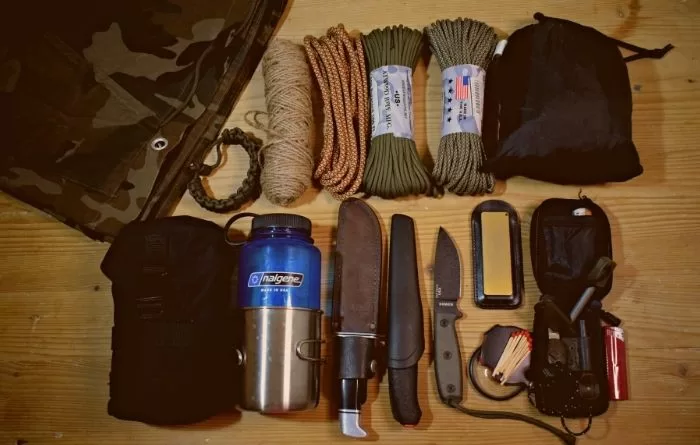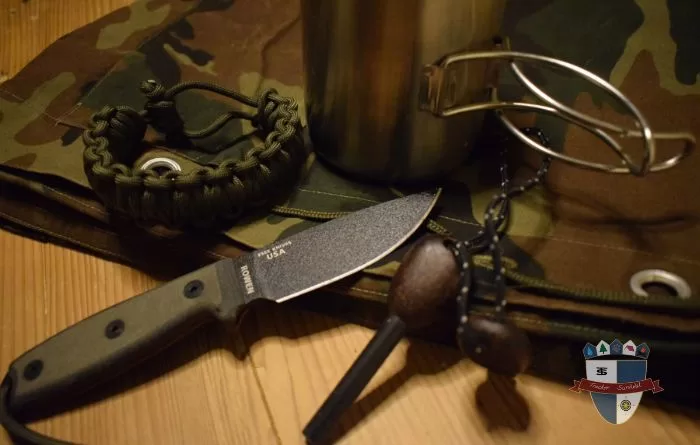5 C’s Of Survival, Everything You NEED To Know
The 5 C’s of survival is a simple mnemonic created to assist a person in assembling a barebones survival kit. Or it can be used as the foundation when assembling a fully kitted-out survival kit. The logic behind the 5 C’s is that they are essential pieces of gear that are extremely difficult for the average person to fabricate from natural materials. And they cover the main basic needs of survival, namely shelter, water, fire, and in an indirect way food.
But… The 5 C’s is just a guide, it is not fixed in stone, depending on a person’s skillset, environment, and situation. Items may be added or replaced. Although why they should be replaced instead of just added is beyond me. Unless for some peculiar reason, there is a 5-item limit.
What Are The 5 C’s Of Survival?
The 5 C’s is the barest minimum that should be in a survival kit, it is by no means meant to represent the entirety of a well-assembled survival kit.
1.Cutting Tool
2.Combustion Device
3.Cover/Shelter
4.Container
5.Cordage
Cutting Tool
Fixed-blade knives, machetes, and axe are prime examples of cutting tools. In the right hands, these make fantastic survival tools.
Many people EDC a folder or multi-tool. And while these make superb backup knives, neither a folder nor a multi-tool should ever be relied on as a primary survival cutting tool.
Combustion Device
Ferro rod, lighter. and matches are fire-making tools. Carry them all. Combined they don’t take up any space at all and weigh practically nothing. A lighter for expediency, matches as backup and a ferro rod as a surefire method of starting a fire. Both lighters and matches have the potential to fail in inclement weather. A ferro rod will not.
Tip: Starting a fire with a ferro rod takes a little bit of practice, so make sure to practice in all weather conditions, not just nice sunny summer days.
Cover
Tarpaulins, bivvys’, ponchos, and tents provide shelter from the elements. They provide a quick and efficient method of setting up a quick shelter.
Almost anyone can throw up a simple lean-to or A-frame shelter with just a simple cutting tool. But it does take energy and time, both of which would be better spent on other survival needs.
Container
A single-walled stainless steel container, preferably a wide-mouthed bottle or canteen. It will be used to transport water, while on the move, and used to boil water to make it potable. If you opt for a nesting cup/canteen system, then it can also be used to prepare simple soups, stews, etc.
Cordage
Often taken for granted in everyday life, in the outdoors cordage has a multitude of uses. Shelter building, traps, fishing, and gear repair, the uses are only limited by a person’s imagination and skills.

Survival Tools
When things go sideways, tools are essential to survival. While primitive living aficionados can makeshift a workable version of the 5 C’s. It is much more practical to have these tools handy. The items listed above take up minimal space, most of these can be packed in an EDC pouch or even in cargo pockets if one is so inclined.
Best Survival Cutting Tool
The consensus is that the best cutting tool is the one you have on you. And while we all wish that if we were in a survival situation, we had a variety of cutting tools, such as a knife, axe, machete, and saw with us. But sadly that is unlikely. Chances are high that at best a person will have a knife and a multi-tool on them. Now if those are the only cutting tools that you have on you. Then you will want to have the best.
Knife
Budget
Mid-Range
High-End
Multi-tool
Chances are high that a person who is carrying an EDC multi-tool will either be carrying a Leatherman or Swiss Army Knife, these 2 are the most popular multi-tool brands today.
Best Survival Fire-starters
The best device to start a fire is a lighter or match. Although they come with their inherent flaws. A lighter can fail and matches do not do well in wet conditions. This is why the vast majority of bushcrafters and survivalists carry a ferro rod (ferrocerium rod). The average ferro rod has thousands of strikes in it, and it will work in adverse conditions. The only flaw with a ferro rod is that starting a fire with one takes practice. This is why any survivalist worth his salt will recommend carrying a lighter, matches, and a ferro rod.

Best Survival Shelter
While it would be fantastic if someone invented a portable shelter that fits in a pocket. All the ones currently on the market are flimsy and can only be used once or twice before they fail. So while not perfect. There are a couple of solutions. A poncho can be used to make a simple lean-to shelter. A tarp is better if you are willing to carry one. Bivies are great, but if it is compact enough to fit in a pocket, it just isn’t durable enough and if you get a durable bivy, it is just too danged big to EDC.
Best Survival Water Container
Water is going to be an issue, we take water for granted. Turn on a tap and voila drinking water. But in the outdoors, all water is suspect and should be treated to make it potable. One of the simplest methods of treating water is boiling. Having a method of carrying and boiling water at all times is essential.
Best Cordage For Survival
Paracord, no question in my mind. Yes… There are better cords out there for specific tasks. But none of them hold a candle to the pure versatility of paracord. While it can be argued that other cords are better at certain things, a survival cord is meant to be a jack of all trades, and paracord fits that description to a T.
Conclusion:
The 5 C’s of survival should be a starting point, it should never be thought of as a complete survival kit. While the 5 C’s cover some basic survival needs, they leave some glaring omissions. For example first aid, navigation, night light, communication/signaling devices, etc.
I EDC the 5 C’s and more since I moved to Europe, all in my little EDC sling bag. On the rare occasions that I do not have my EDC bag with me. I always have a pocket knife, multi-tool, paracord bracelet, lighters (at least 2), water bottle with nesting cup, and a space blanket with me. Everything but the water bottle and nesting cup goes in my pockets (those go in a little 5.11 hydration pouch that I just hang on my belt).
The more skilled an individual is, the less gear they need to carry with them. A skilled outdoorsman can build a shelter, fabricate the tools needed to start a fire, whittle a container, and whip up some cordage with just a good knife.